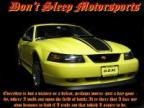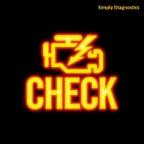*** Restricting New Posts to SD Premium Members ONLY *** (09 May 2025)
Just made a new account? Can't post? Click above.
Scope captures and questions
- JoesAutoElectric
-
 Topic Author
Topic Author
- Offline
- Senior Member
-

Also I have another thing to run by you guys. If I wanted to determine firing order on this engine while doing this test, how would you go about it? I mean, you have to disable the ignition to get the relative compression waveform, so no way to sync with a secondary probe. Thanks guys.
"The man who says it cannot be done should not interrupt the man doing it."
Please Log in or Create an account to join the conversation.
- mech1965
-
- Offline
- New Member
-

- Posts: 1
- Thank you received: 0
Please Log in or Create an account to join the conversation.
- JoesAutoElectric
-
 Topic Author
Topic Author
- Offline
- Senior Member
-

"The man who says it cannot be done should not interrupt the man doing it."
Please Log in or Create an account to join the conversation.
- Andy.MacFadyen
-

- Offline
- Moderator
-

- Posts: 3353
- Thank you received: 1037
Generally where something shows up on a cranking compression test your going to have to get out the compression gauge or leak down gauge and test multiple cylinders anyway. With such prounced (apparent) lean mis-fire identified I iwould go straight for a leakdown test on identified cylinder and would expect to find a major exhust valve sealing issue.
" We're trying to plug a hole in the universe, what are you doing ?. "
(Walter Bishop Fringe TV show)
Please Log in or Create an account to join the conversation.
- JoesAutoElectric
-
 Topic Author
Topic Author
- Offline
- Senior Member
-

"The man who says it cannot be done should not interrupt the man doing it."
Please Log in or Create an account to join the conversation.
- JoesAutoElectric
-
 Topic Author
Topic Author
- Offline
- Senior Member
-

"The man who says it cannot be done should not interrupt the man doing it."
Please Log in or Create an account to join the conversation.
- Andy.MacFadyen
-

- Offline
- Moderator
-

- Posts: 3353
- Thank you received: 1037
With engine running the pressure will be even lower because the pressure in the inlet manifold will be even lower than it is cranking the engine with the throttle closed.
Another thing to allow for is the length of extension tube between gauge and the spark plug hole has a major effect on the peak pressure reading, a long extension reduces the compression raito.
Now turning to your scope compression test I think something is wrong with your setup what I don't know,
" We're trying to plug a hole in the universe, what are you doing ?. "
(Walter Bishop Fringe TV show)
Please Log in or Create an account to join the conversation.
- Doc
-

- Offline
- Senior Member
-

- Sharing the little I know
- Posts: 58
- Thank you received: 12
The pressure is not dropping to zero so either you have a plugged exhaust, valves not opening or a hardware problem with your scope.
HTH
PS just looked at your cranking amps and secondary captures - there is something amiss with the way this engine is breathing - sticking valves, valve timing, blocked intake or exhaust, what I'm seeing does not add up at all.
Youtuber specialising in Diagnostic techniques, sharing skills and helping technicians be the best they can be #Picoflu
Please Log in or Create an account to join the conversation.
- JoesAutoElectric
-
 Topic Author
Topic Author
- Offline
- Senior Member
-

"The man who says it cannot be done should not interrupt the man doing it."
Please Log in or Create an account to join the conversation.
- Doc
-

- Offline
- Senior Member
-

- Sharing the little I know
- Posts: 58
- Thank you received: 12
Can you upload the psdata file?
the noise on your top capture, does this coincide with an ignition event? If so, I would say the coil is firing way before it should be.
My own preference is not to filter out noise as it can be a great source of information as to what else is going on in the engine bay without having to dedicate a scope channel to it.
Youtuber specialising in Diagnostic techniques, sharing skills and helping technicians be the best they can be #Picoflu
Please Log in or Create an account to join the conversation.
- JoesAutoElectric
-
 Topic Author
Topic Author
- Offline
- Senior Member
-

"The man who says it cannot be done should not interrupt the man doing it."
Please Log in or Create an account to join the conversation.
- Doc
-

- Offline
- Senior Member
-

- Sharing the little I know
- Posts: 58
- Thank you received: 12
Very useful for known goods etc.
Re: noise, looking at the noise on that capture it is possible for the transducer, lead or scope to pick up noise from an ignition or injection event and to draw it. The spacing of the noise makes me think it may be Ignition and the timing of it looks too far away from TDC.
To add a ignition sync just select secondary ignition probe from ChB drop down and put it on any known ign lead, you can work out cyl ID using the firing order from there.
Paul does this in a lot of his videos featuring relative compression tests.
Hope this helps (HTH)
Steve...
Youtuber specialising in Diagnostic techniques, sharing skills and helping technicians be the best they can be #Picoflu
Please Log in or Create an account to join the conversation.
- Tyler
-

- Offline
- Moderator
-

- Full time HACK since 2012
- Posts: 6049
- Thank you received: 1522
Please Log in or Create an account to join the conversation.
- JoesAutoElectric
-
 Topic Author
Topic Author
- Offline
- Senior Member
-

"The man who says it cannot be done should not interrupt the man doing it."
Please Log in or Create an account to join the conversation.
- Doc
-

- Offline
- Senior Member
-

- Sharing the little I know
- Posts: 58
- Thank you received: 12
You can look at ignition when cranking, just disable the fuel system i.e. if mechanical lift pump just pull or clamp the suction line from tank to pump or if electric pump then pull the fuse.
Your sync does not have to be on the same cylinder - it is easily worked out using firing order and you will inevitably have enough noise on one of the channels to be able to work out where the firing event is. In any case just earth the plug lead using a test light to GND and you can use the same cylinder as the transducer is fitted to.
HTH
Steve...
Really recommend you watch Pauls videos on relative compression and cylinder ID / sync
Youtuber specialising in Diagnostic techniques, sharing skills and helping technicians be the best they can be #Picoflu
Please Log in or Create an account to join the conversation.

